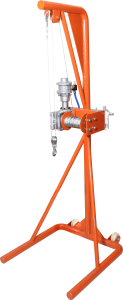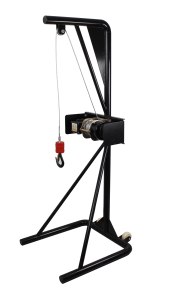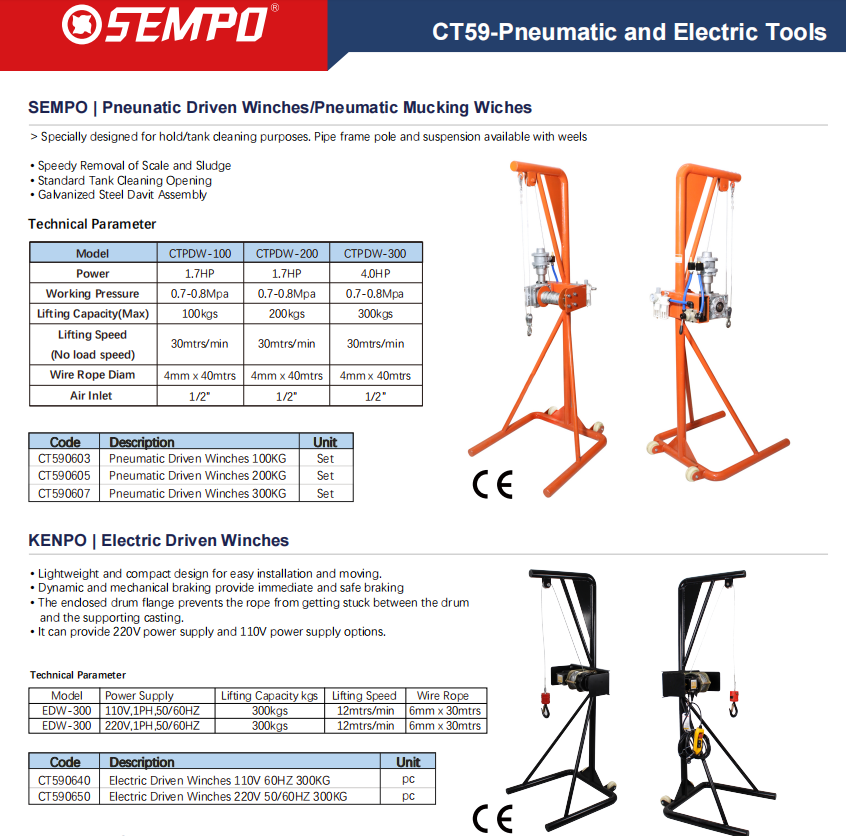In marine operations, winches are essential for various tasks including lifting, pulling, and mooring. Two widely utilized types of winches in maritime environments are Marine Pneumatic Driven Winches and Electric Driven Winches. Each type presents distinct advantages and disadvantages, making it imperative for ship chandlers and operators to comprehend these differences in order to select the most appropriate option for their specific requirements. This article will examine the primary features, benefits, and considerations associated with both types of winches to assist you in making an informed choice.
Overview of Winch Types
Marine Pneumatic Driven Winches
Marine Pneumatic Driven Winches operate using compressed air, rendering them suitable for a range of marine applications, particularly in situations where electrical power is either limited or poses safety risks. Models such as the CTPDW-100, CTPDW-200, and CTPDW-300 are engineered for high performance, with maximum lifting capacities between 100 kg and 300 kg. These winches function at a working pressure of 0.7-0.8 Mpa and can achieve a no-load lift speed of 30 meters per minute, making them effective for tasks like tank cleaning and the handling of heavy equipment.
Key Features:
- High Lift Speed: Capable of lifting at speeds reaching 30 meters per minute.
- Compact and Lightweight: Designed for straightforward installation and mobility.
- Durability: Constructed from galvanized steel to ensure longevity and resistance to marine conditions.
- Safety: Minimizes electrical hazards, particularly in wet environments.
Electric Driven Winches
Electric Driven Winches rely on electrical power for operation, providing a different array of benefits. Models such as the EDW-300 can manage a maximum lift capacity of 300 kg and are available in both 110V and 220V configurations. These winches are tailored for general lifting and pulling applications, featuring dynamic and mechanical braking systems to enhance safety.
Key Features:
Versatility: Applicable for a diverse array of lifting tasks.
User-Friendly: Generally simpler to operate with intuitive controls.
Reliable Power Supply: Ensures a steady and dependable source of power.
Compact Design: Facilitates installation in various marine environments.
Comparison of Pneumatic and Electric Driven Winches
Power Source
A primary distinction between pneumatic and electric winches lies in their power sources. Pneumatic winches utilize compressed air, which is beneficial in hazardous settings where electrical sparks may present a danger. This characteristic makes pneumatic winches particularly well-suited for tank cleaning operations, where the potential for explosions is heightened.
Conversely, electric winches depend on a stable electrical supply. In marine contexts, this can pose a challenge if the power source is inconsistent or unavailable. Nevertheless, electric winches are more prevalent and can be seamlessly integrated into standard ship power systems, thereby enhancing their applicability in numerous situations.
Performance
Regarding performance, each type of winch possesses unique advantages. Marine Pneumatic Driven Winches can swiftly lift substantial loads and are less prone to overheating, as they do not depend on electrical components. Their rapid lifting speed and high capacity render them ideal for urgent tasks, such as during emergencies or when handling hazardous materials.
Electric Driven Winches provide consistent power and are typically easier to manage, making them appropriate for applications that require precise lifting. Additionally, they are generally quieter than pneumatic winches, which can be a crucial consideration in environments where noise reduction is essential.
Maintenance
Maintenance is a vital aspect to consider when selecting between pneumatic and electric winches. Pneumatic winches generally necessitate routine inspections of the air supply, as well as the condition of hoses and fittings. While the lack of electrical components reduces the likelihood of electrical malfunctions, it is essential for operators to maintain the air system properly to avoid any performance-related issues.
On the other hand, electric winches demand electrical maintenance, which includes checking wiring, circuits, and the functionality of the motor. Although they may possess more components that are susceptible to failure, recent advancements in electric winch technology have led to systems that are increasingly reliable and easier to maintain.
Cost
Cost is frequently a crucial factor for ship chandlers and operators. Pneumatic winches may entail a higher initial investment due to the requirement for a compressed air system. Nevertheless, their robustness and reduced risk of electrical failure can result in long-term cost savings.
Conversely, electric winches typically have a lower initial cost and are readily available, making them more accessible to a broader range of operators. However, ongoing electrical expenses and potential maintenance costs can accumulate, particularly if the winch is utilized frequently.
Conclusion
The decision between Marine Pneumatic Driven Winches and Electric Driven Winches is ultimately contingent upon the specific needs of your marine operations. In environments characterized by hazardous conditions or where rapid lifting is essential, pneumatic winches may prove to be the superior option. Their inherent safety features and effectiveness in challenging tasks render them particularly suitable for specialized operations, such as tank cleaning.
Conversely, if your operations primarily involve standard lifting tasks and you have consistent access to electrical power, electric winches may provide the versatility and user-friendliness required. Their simple operation and lower initial costs can be advantageous for general applications.
In summary, a thorough understanding of the advantages and disadvantages of each winch type will empower ship chandlers and marine operators to make well-informed choices that improve efficiency, safety, and overall operational performance. Regardless of whether you opt for pneumatic or electric winches, it is crucial to ensure that you possess the appropriate equipment tailored to your specific needs for successful marine operations.
Post time: Mar-10-2025









